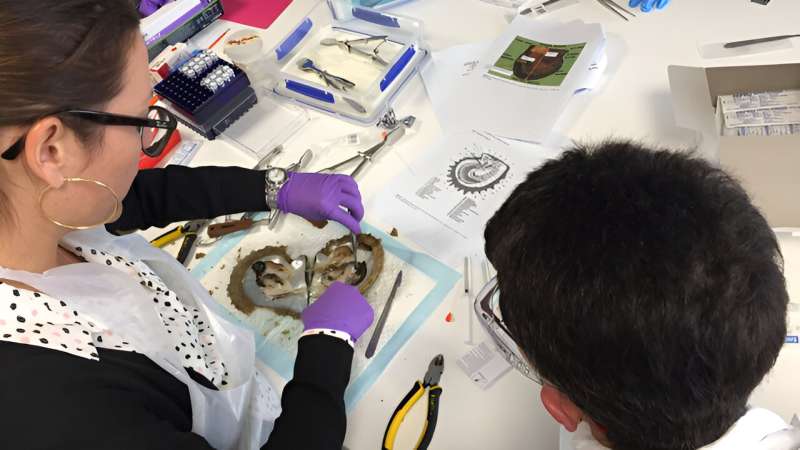Seismic survey not expected to impact oyster yield in Australian waters

New research suggests that exposure to a single seismic survey is unlikely to increase mortality or affect pearl production in adults of an oyster species farmed in Australian waters.
In a study led by Australian Institute of Marine Science (AIMS) researchers, and published in Marine Pollution Bulletin, about 11,000 silverlip pearl oysters (Pintada maxima) were exposed during a dedicated four-day seismic source survey.
They were then monitored over a two-year period with results indicating the surveys were unlikely to have had an effect on the quality or quantity of pearls produced.
Dr. Miles Parsons, an AIMS acoustic scientist and lead author on the study, said the research reduced previous uncertainty for this species.
"It has given us valuable real-world results," he said.
"It is important to recognize that this was the first time anyone has used a dedicated seismic vessel and a commercial-sized airgun array to look at the effects of seismic energy on this species in an area where pearl oysters are commercially farmed.
"Previous studies into the effects of seismic energy on mollusks—the family of marine invertebrates to which oysters belong—had found damage to cells, adverse changes in behavior and impairment of immune systems, and in some cases, mortality, raising concerns. But some of these studies involved small-scale, laboratory, and single-airgun trials or opportunistic sampling designs.
"The robust design and delivery of our experiment means our findings reduce uncertainty and allow managers, marine industries and policy makers to make more informed decisions about the sustainable use of seismic surveys in relation to this species."
The silverlip pearl oyster is a dinner plate–sized species found in the Indo-Pacific region and is a valuable species for jewelry. Western Australia's pearling industry, estimated to be worth $67 million in 2014, grows the oysters commercially in waters off the Pilbara and the Kimberley—an area that overlaps with offshore oil and gas exploration and development.
A seismic vessel and a commercial-sized airgun array were used for the research at various distances from groupings of oysters in Roebuck Bay, south of Broome in Western Australia.
In seismic surveys, an airgun array produces loud, repetitive underwater sounds that penetrate the sea floor. The rebounding sound creates detailed pictures of the rock layers below the seabed, allowing industry to locate oil and gas deposits.
Oysters from one of the four seismic survey days exhibited higher levels of mortality and lower pearl production than other days, but oysters from many other test groups that received similar or higher levels of exposure did not display the same response. Dr. Parsons said it was likely an unknown stressor had driven this response, rather than the seismic survey, but scientists could not rule out that an unknown factor might have worked in synergy with seismic exposure to affect these oysters.
The research was part of a wider experiment conducted in 2018 which also looked at responses to seismic surveys of commercially valuable demersal fish species in the north west Australian environment.
The research was a collaboration between AIMS, The University of Western Australia, Curtin University, the Department of Primary Industries and Regional Development, University of Tasmania and collaborators from the Australian pearling industry and was part of the North West Shoals to Shore Research Program.
More information: Miles J.G. Parsons et al, A large-scale experiment finds no consistent evidence of change in mortality or commercial productivity in silverlip pearl oysters (Pinctada maxima) exposed to a seismic source survey, Marine Pollution Bulletin (2023). DOI: 10.1016/j.marpolbul.2023.115480
Journal information: Marine Pollution Bulletin
Provided by Australian Institute of Marine ScienceSeismic surveys have no significant impact on commercially valuable fish in NW Australia
No comments:
Post a Comment